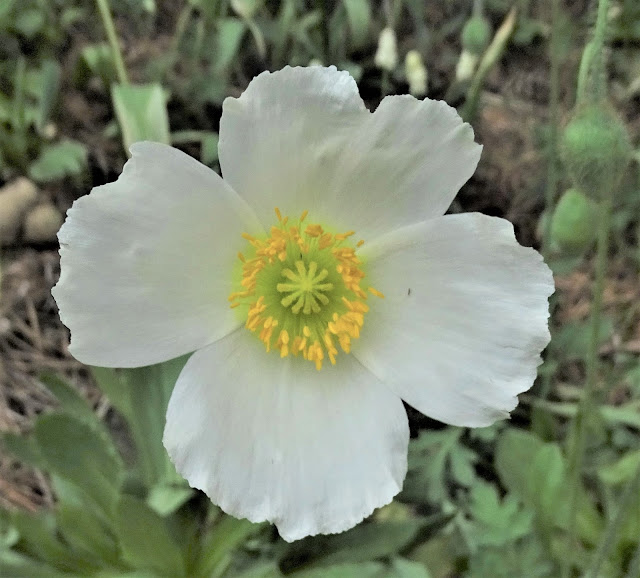 |
| Papaver commutatum and umbel |
Years ago I gave a talk about Mediterranean plants: the blurb in our education supplement mentioned that I would talk about bulbs, trees, shrubs, lots mints and poppies among other items. I gave a pretty good talk I thought--but afterwards a lady came up more than a little irate: putting the talk together I'd inadvertently omitted the poppies--and she'd driven 200 miles from Western Colorado just to see those poppies. Poppy lovers are a serious bunch--and I know. I'm one of them! Above a twinning of an umbel (I grow a lot of them--not sure which one this was) and perhaps my favorite poppy. Nonsense! I love them all!
 |
| Papaver comutatum and Tragopogon reticulatus Turtle Lake. Republic of Georgia |
Poppies embody the quality of evanescence perhaps better than any plant: the crepe-like ripples of their silken flowers, the way they sway on the delicate stems--what other plant embodies the fleeting moment like this? Old gardeners know that gardens are naught but shimmering mirages. But then so is life. Which is why we must grasp the poppy (so to speak)!
 |
| Papaver commutatum in a cultivated field near Lagodechi, Republic of Georgia |
And at the same time, poppies make perhaps the most spectacular mass flowerings of any plant.
{ P P |
| Papaver nudicaule in Mongolia |
And some can bloom for months on end. "Iceland poppies" in Central Asia can be found blooming any time during the growing season. They bloom non-stop in our mountain towns in Colorado.
 |
| Papaver tauricolum |
This is one of my "signature weeds"--cousin to the better known P. triniaefolia--this is a tad more orange and just as vigorous.
One year it nearly swamped my back yard!
 |
| Papaver anomalum |
One species I have a special fondness for is this anomalous one--which superficially resembles P. nudicaule, only it is much more heat tolerant, blooming more or less straight through the summer hot months. I finally found a spot in my garden where it persists and even self sows moderately! (One of my goals in gardening is to grow every plant I love so that it persists forever: don't laugh please).
 |
| Closer view Papaver anomalum |
 |
| Papaver rhoeas |
Here a colleague at Applewood Seed Company at their test garden in Arvada is comparing the pure white colored sexual parts in one flower with the black in another: there are some wonderful variations.
 |
| Papaver rhoeas |
I have a rather compact, orange form of P. rhoeas that's decided to colonize my rock garden: it's a tad too big, and likes to grow atop the rarest tiny alpines: but I always leave a few...punishment for being a poppy lover!
 |
| Or perhaps more than a few... |
 |
| But not as many as I was blessed to find in a fallow field on the island of Paros... |
In the depths of winter, nothing quite warms the cockles of a plantsman's heart than the thought of poppies soon to emerge from winter dormancy. Not too many more months and we'll be treated to their dance, bobbing and swaying in the warm spring breeze!
(This post is dedicated to my two most poppy besotted friends, Mike Bone and Marilyn Raff!)





No comments:
Post a Comment